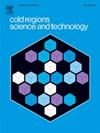In-cloud ice accretion and performance degradation of UAV propellers in forward flight: An experimental study
IF 3.8
2区 工程技术
Q1 ENGINEERING, CIVIL
引用次数: 0
Abstract
An experimental study of ice accretion on a rotating UAV propeller blade was conducted under diverse environmental conditions. This research aimed to study the effects of varying independent environmental parameters on the characteristics and morphology of the accreted ice as well as its influence on propeller's performance. These experiments were carried out at the Anti-icing Materials International Laboratory (AMIL) Icing Wind Tunnel (IWT) at the Université du Québec à Chicoutimi (UQAC), Canada. The icing conditions are determined in accordance with the 14 CFR Part 29 Appendix-C for rotorcraft operating at altitudes below 10,000 ft. The analysis of results revealed that increase in Liquid Water Content (LWC) values can significantly affect the ice accretion rates. Higher LWC intensifies ice accretion, leading to a sharp initial drop in thrust and a rapid rise in power demand; however, it is observed that these variations gradually saturate after the initial aggressive degradation phase. Increasing Median Volume Diameter (MVD) can significantly affect the nature, morphology, and mass of accreted ice. The thin propeller sections were highly sensitive to increase in droplet size, leading to increase collection efficiencies. In some cases, an increase in MVD could trigger a transition in the ice accretion regime from rime to glaze ice. Also, the ice transitioned from soft rime to hard glaze as atmospheric temperatures approached the freezing point. Such transitions resulted in significative increase in the severity of the aerodynamic performance degradation. Elevated values of LWC and MVD at temperatures close to the freezing point led to the development of severe ice formations characterized by ice horns along the leading edge, intricate ice structures near the blade tip and fast degradation of aerodynamic performance. During ice accretion, thrust decreases linearly, while input power increases quadratically with RPM. The 3D scans of the final ice shapes obtained in this research not only offered detailed insights into the ice morphology but will also serve to validate numerical ice accretion models in future work. Performance penalties were notably more significant during the first 50 s of ice accretion, indicating a necessity for ice protection systems with low reaction times in rotary wing UAVs.
无人机螺旋桨前飞时云中结冰与性能下降的实验研究
对无人机螺旋桨叶片在不同环境条件下的吸冰特性进行了实验研究。本研究旨在研究不同独立环境参数对增冰特性和形态的影响,以及对螺旋桨性能的影响。这些实验是在加拿大quacei大学(UQAC)的防冰材料国际实验室(AMIL)结冰风洞(IWT)进行的。结冰条件是根据14 CFR第29部分附录c确定的,用于在低于10,000英尺的高度运行的旋翼飞机。结果分析表明,液态水含量(LWC)值的增加会显着影响冰的增加速率。较高的LWC加剧了冰的增加,导致推力的急剧下降和电力需求的迅速上升;然而,观察到这些变化在初始侵蚀降解阶段后逐渐饱和。增加中位体积直径(MVD)可以显著影响冰的性质、形态和质量。薄螺旋桨截面对液滴尺寸的增加高度敏感,从而提高了收集效率。在某些情况下,MVD的增加可能引发冰的增生状态从霜冰到釉冰的转变。此外,当大气温度接近冰点时,冰从软霜转变为硬釉。这样的转变导致空气动力性能下降的严重程度显著增加。在接近冰点的温度下,LWC和MVD的升高导致了严重的冰形成,其特征是沿前缘形成冰角,叶尖附近形成复杂的冰结构,气动性能迅速下降。在增冰过程中,推力呈线性减小,而输入功率随转速呈二次增长。在这项研究中获得的最终冰形状的3D扫描不仅提供了对冰形态的详细见解,而且还将在未来的工作中用于验证数值冰吸积模型。在结冰的前50秒,性能损失尤为显著,这表明旋翼无人机需要具有低反应时间的防冰系统。
本文章由计算机程序翻译,如有差异,请以英文原文为准。
求助全文
约1分钟内获得全文
求助全文
来源期刊

Cold Regions Science and Technology
工程技术-地球科学综合
CiteScore
7.40
自引率
12.20%
发文量
209
审稿时长
4.9 months
期刊介绍:
Cold Regions Science and Technology is an international journal dealing with the science and technical problems of cold environments in both the polar regions and more temperate locations. It includes fundamental aspects of cryospheric sciences which have applications for cold regions problems as well as engineering topics which relate to the cryosphere.
Emphasis is given to applied science with broad coverage of the physical and mechanical aspects of ice (including glaciers and sea ice), snow and snow avalanches, ice-water systems, ice-bonded soils and permafrost.
Relevant aspects of Earth science, materials science, offshore and river ice engineering are also of primary interest. These include icing of ships and structures as well as trafficability in cold environments. Technological advances for cold regions in research, development, and engineering practice are relevant to the journal. Theoretical papers must include a detailed discussion of the potential application of the theory to address cold regions problems. The journal serves a wide range of specialists, providing a medium for interdisciplinary communication and a convenient source of reference.
 求助内容:
求助内容: 应助结果提醒方式:
应助结果提醒方式:


